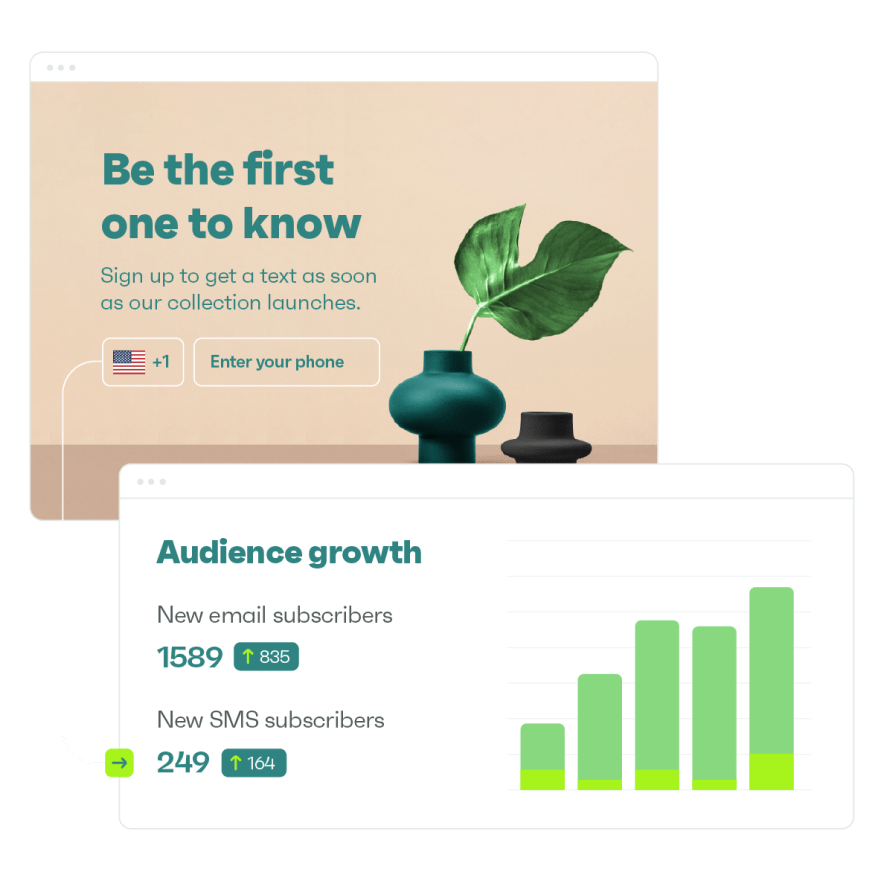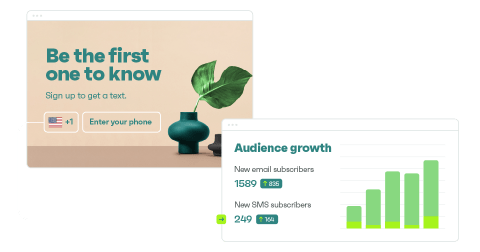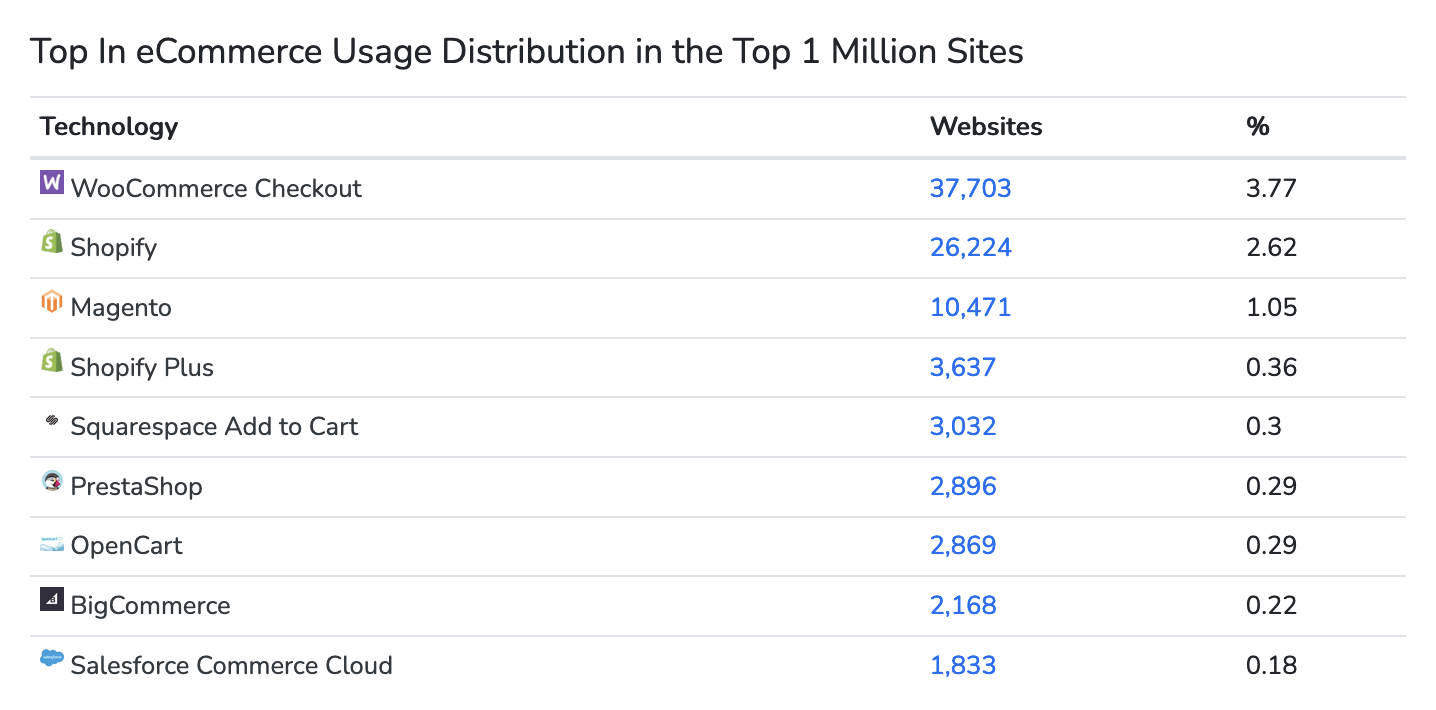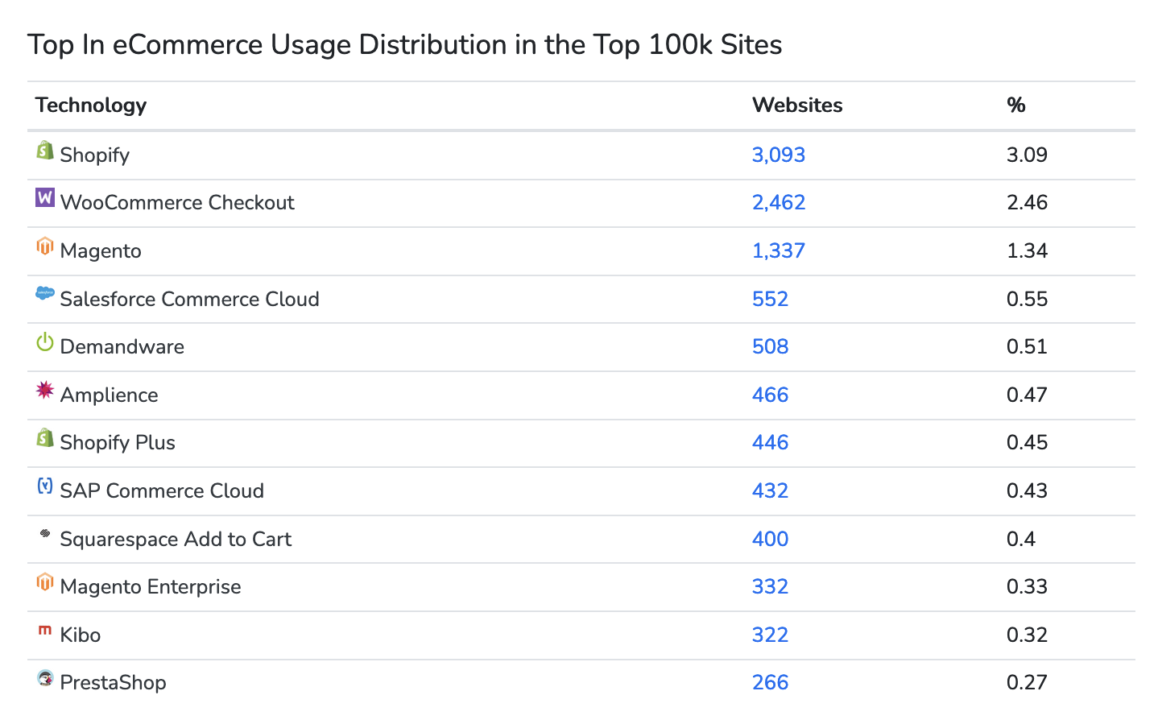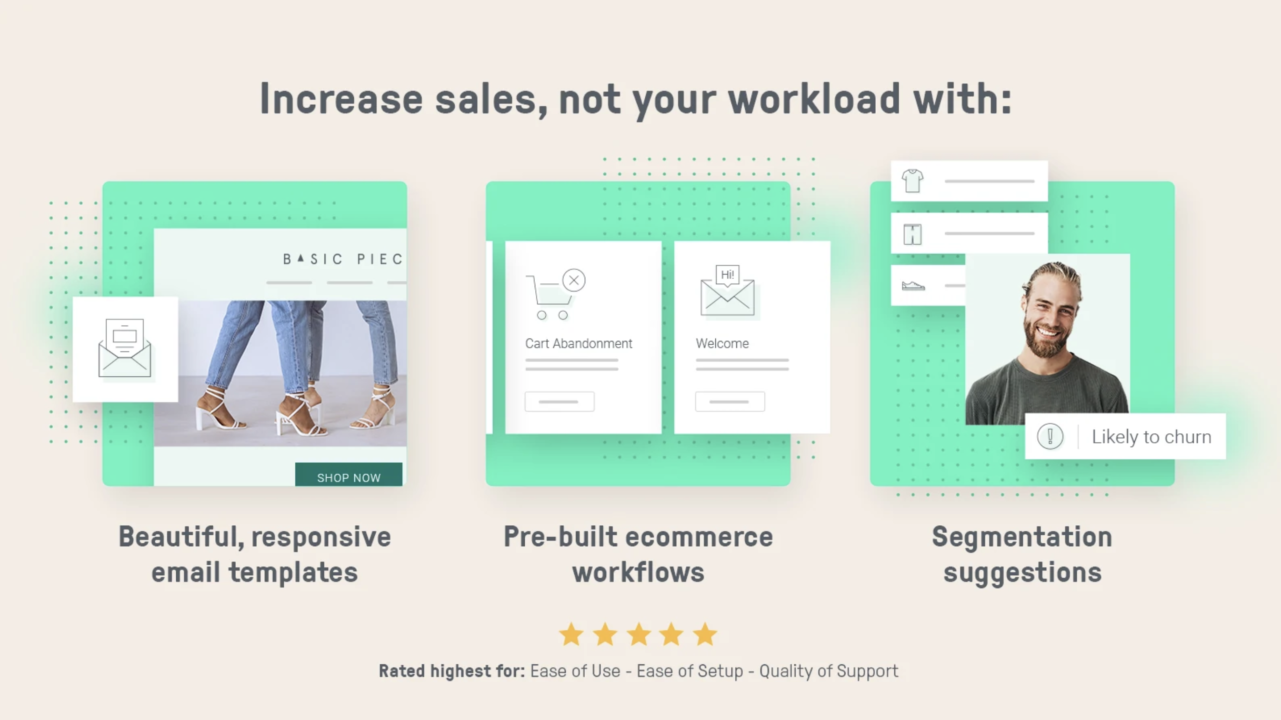Drive sales on autopilot with ecommerce-focused features
See FeaturesBigCommerce vs Shopify: A feature-by-feature comparison
If you’re planning to set up an online store, BigCommerce vs Shopify is one of the most important comparisons you’ll need to examine. You’ll need to determine which one has the features that match the vision you have for your shop, as well as ease-of-use to help minimize the effort required to run your business.
Shopify is a staple brand in ecommerce. It has one of the largest market shares among online stores for good reason. It is easy to use even for people without any web programming knowledge. And, through its built-in features and available themes, Shopify allows you to set up your shop and start selling your products in no time.
In contrast, BigCommerce isn’t among the most widely used ecommerce platforms. Nevertheless, it is undeniably among the best Shopify alternatives because it is comparable in price even when it offers more product and sales features than what’s built into a typical Shopify plan.
Whether you choose Shopify or BigCommerce, Omnisend lets you automate your marketing across various channels so you can generate sales on autopilot. Start free.
BigCommerce vs Shopify
On the surface, Shopify vs BigCommerce might not even seem like a useful discussion since Shopify’s market share far surpasses that of BigCommerce.
According to BuiltWith data, Shopify is used by 2.62% of the top one million websites based on traffic, and 20% of websites that use ecommerce software. It is more popular than Magento and second only to WordPress’ WooCommerce Checkout.
BigCommerce has a much smaller market share at 0.22% of the top one million high-traffic sites. When you consider only the top 100,000 websites based on traffic, Shopify surpasses WooCommerce and becomes the most popular ecommerce platform while BigCommerce doesn’t even make it to the top ten.
So, based on usage and popularity, Shopify is definitely the winner. But is that a good reason to dismiss BigCommerce entirely? Apparently, a comprehensive comparison of these two technologies shows that BigCommerce offers several advantages. Choosing either Shopify or BigCommerce would depend heavily on the specific features you seek for the unique requirements of your online business.
In-depth BigCommerce vs Shopify comparison
To help you choose the best platform for your ecommerce venture, here’s a compilation of valuable insights from several of the most credible BigCommerce vs Shopify reviews. It breaks down the comparison into the most critical deciding factors and determines each platform’s benefits and potential disadvantages.
By the end of this report, you’ll have a good understanding of each platform’s features, pricing, and user-friendliness. You’ll also see which one has a better selection of themes and apps that are critical to your website’s design and functionality. Additionally, you’ll see whether BigCommerce or Shopify has better security features and quality of support.
Let’s begin.
Website Builder Features
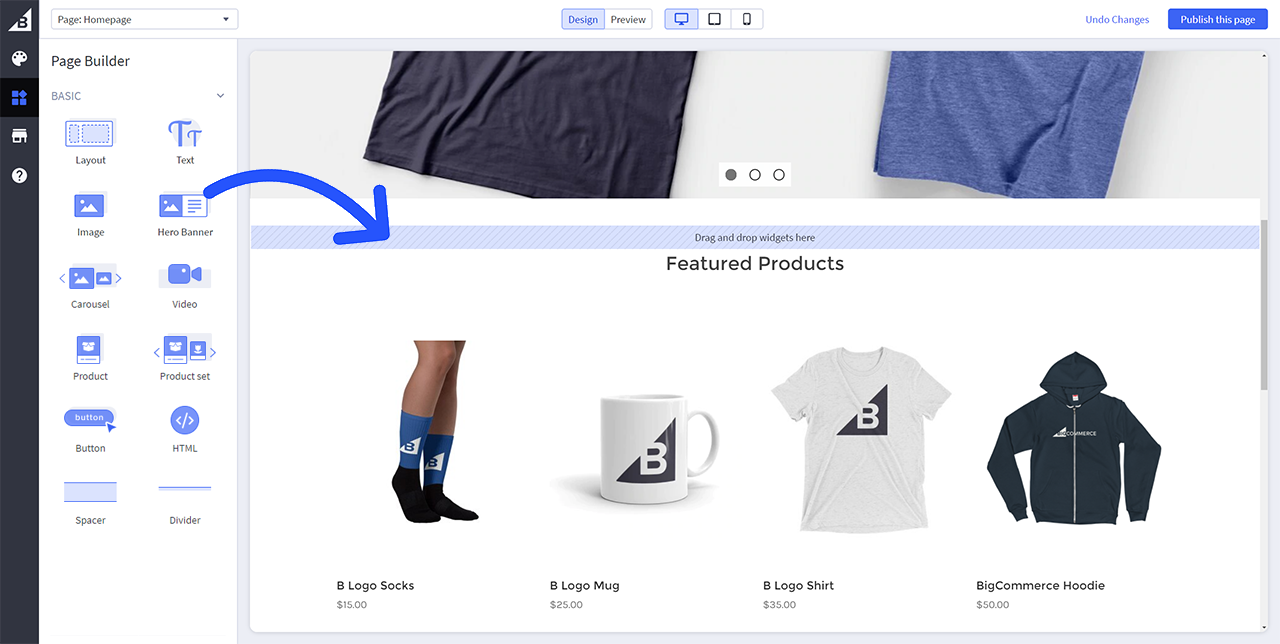
Among the most commonly praised BigCommerce features is its website builder. If you’re creating a store without a programming background, you’ll appreciate its drag-and-drop interface. It lets you design web pages by selecting elements and laying them out with the use of your mouse. BigCommerce also ensures that all pages created on the platform are responsive, so you don’t miss out on sales from shoppers on mobile devices.
Additionally, BigCommerce has a built-in blog that you can use to engage your target audience and establish your reputation as an expert in your niche. Maintaining a blog will also be valuable for SEO and driving targeted traffic to your ecommerce store.
Similarly, Shopify features also include a built-in blogging engine that functions practically the same way as BigCommerce’s. It also lets you build a mobile responsive online store without having to write a single line of code. And even if it doesn’t have the same drag-and-drop interface as BigCommerce, Shopify’s themes are customizable enough so that it doesn’t take much effort to implement whatever you envision for your ecommerce store.
All things considered, you’ll be able to get your store up and running much more quickly on Shopify. But if you’re after more customization features and don’t mind taking extra time before generating sales, BigCommerce features win in this regard.
Pricing
BigCommerce pricing is only higher than Shopify by $0.95 per month. The cost of the two platforms is comparable on every plan. The inclusions of each are comparable as well.
Here’s a BigCommerce vs Shopify pricing comparison:
| Shopify | BigCommerce | |||||
| Plan | Basic | Shopify | Advanced | Standard | Plus | Pro |
| Pricing (monthly) | $29.00 | $79.00 | $299.00 | $29.95 | $79.95 | $299.95 |
| Staff accounts | 2 | 5 | 15 | Unlimited | Unlimited | Unlimited |
And here’s what you get with each plan:
| Shopify | BigCommerce | |
| Ecommerce store | ✅ | ✅ |
| No. of products | Unlimited | Unlimited |
| Blog | ✅ | ✅ |
| Multichannel selling | ✅ | ✅ |
| Payment processing | Via Shopify Payments | Via 3rd party app |
| Shipping | Via Shopify Shipping | Via 3rd party app |
If you have a large team or plan to scale up quickly, make sure you pay attention to the allowable number of staff accounts per plan. Shopify has access limits while the number of team members who can use your platform is unlimited on BigCommerce.
Payment processing transaction fees are not easily calculated but you’ll need to examine which platform will be more beneficial for you. Shopify has Shopify Payments, which enables you to accept a wide variety of payment options. If you opt to use another payment processor, Shopify charges a 2% transaction fee. In contrast, BigCommerce doesn’t have its own payment processing facility but will not charge you any transaction fees to use a 3rd party service.
If you have the resources to make upfront payments, you can avail of a 10% discount which both Shopify and BigCommerce offer on annual plans. That gives you savings of almost $100 per year on either the standard Shopify plan or the BigCommerce Plus plan.
If you have access to even more resources, you can avail of biennial Shopify pricing. This lets you save 20% of monthly fees as long as you’re willing to pay for two years up front. BigCommerce pricing doesn’t offer discounts beyond the 10% for annual payments.
To help you be absolutely sure of your choice of platform without risk, both BigCommerce and Shopify offer free trials without requiring you to submit any credit card information. Shopify’s free trial lasts 14 days while BigCommerce’s risk-free trial period is 15 days long.
Ease of use
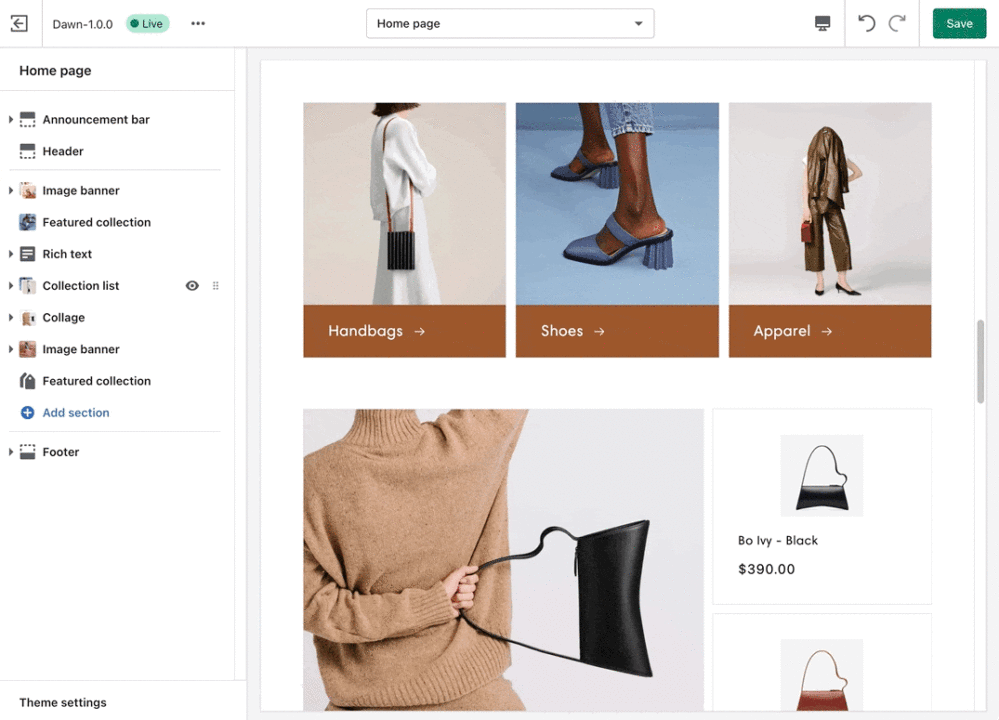
In terms of user experience, the BigCommerce vs Shopify debate doesn’t have a clear winner. This topic must be examined on two sides: the development side and the operational side.
When developing an ecommerce store, most users agree that Shopify is easier to use despite the superior drag-and-drop interface of BigCommerce. This is because the Shopify platform is generally more intuitive. And, the number of Shopify themes available makes it easier for you to find one that will require very little customization to implement exactly what you envisioned for your online store.
If you’re not keen on building your website yourself, however, it’ll be easy to find professional developers whether you choose BigCommerce or Shopify. In that case, the ease of use for development shouldn’t really matter to you. What will matter is how easy it will be to maintain your business and manage your store’s operations.
As a CMS, BigCommerce offers more advantages. It might take a little more effort to learn how to maximize the use of the platform but its built-in features make it the superior choice as the extra features make it easier for you to run your business.
For example, BigCommerce features include the ability to collect and publish product reviews on the same business platform. On Shopify, this feature is available through apps or third-party services, each with its own learning curve.
Best design

All BigCommerce plans make it easy for you to create professional-looking ecommerce stores but Shopify wins in terms of quality of design. The best Shopify stores succeed not only because of beautiful color, layout, and graphic choices but also because of thoughtful user experience design that works to maximize conversions.
More professional web designers create templates for Shopify than for BigCommerce. This means Shopify offers a better chance of finding a theme with the most appropriate graphic and functional design for your business. Additionally, there are more unique templates for Shopify, which means your store won’t look like everyone else’s just because you chose the same ecommerce platform.
Nevertheless, despite the lack of readily available design options for BigCommerce, it could be the better option if you’re up to putting in more effort for customization. BigCommerce templates tend to look alike but the customization options it offers give you much more creative freedom.
So, if you want a good design that requires very little tweaking, Shopify wins. But if you don’t mind doing more work to design a truly unique online store, BigCommerce is the better option.
Best for product features
Whether you choose Shopify or BigCommerce, you can have an unlimited number of products to sell. But BigCommerce features are more sophisticated than those of Shopify.
Among the most valuable advantages of BigCommerce is the availability of product variations. On Shopify, you can offer up to 100 variations of a product across three options (e.g. color, pattern, and size). BigCommerce allows you to offer up to 600 variations for every product without any limitations on the number of options.
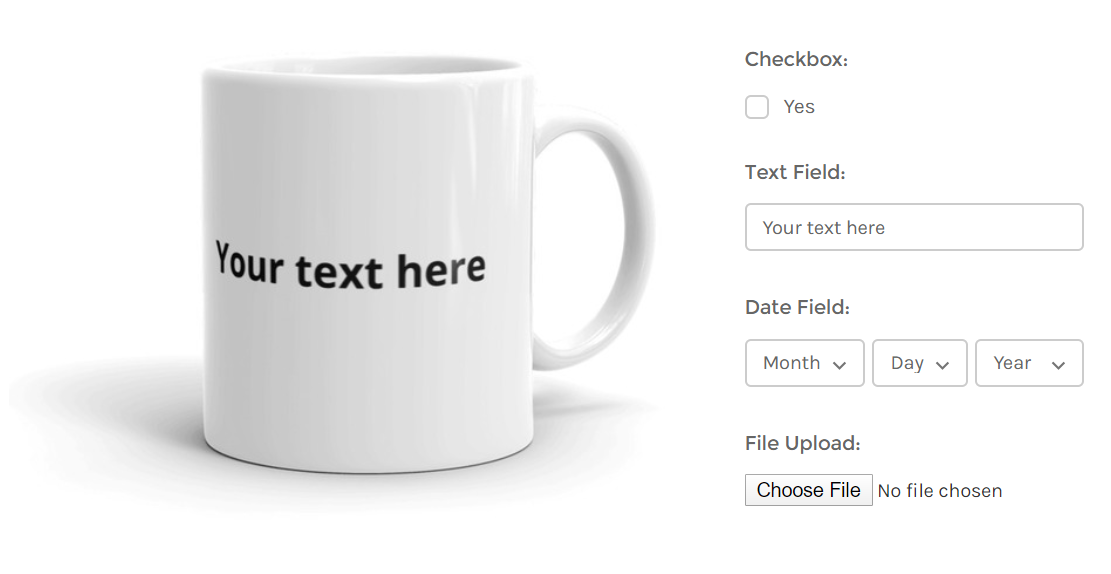
Additionally, BigCommerce allows for better product customization. For example, you can provide a text field so your customers can enter custom text that will appear on their orders. You can also let them upload photos, which is useful for on-demand custom printing services.
To make all these features possible on the Shopify platform, you’ll need to rely on apps and plugins. That might give you the same functionalities but such additional services will likely incur additional costs.
Best for inventory management
Inventory management features are essential if your business sells physical goods. If you don’t handle this properly, it could be a source of great frustration from your customers. Ultimately, delays and cancellations due to poor inventory management systems can lead to a bad brand reputation and overall business failure.
When comparing BigCommerce vs Shopify inventory management features, BigCommerce wins in many ways. Its built-in functionalities enable you to track inventory at a glance and in real time. It also lets you set up low-stock notifications, which can be useful both for informing your stocking decisions and for driving urgency among interested customers.

Although BigCommerce is better in this regard, Shopify doesn’t lag too much behind. In fact, it offers a few benefits that BigCommerce lacks. For example, Shopify can handle inventory across several locations. This is useful if you have several branches of retail stores and warehouses in different locations. Shopify features are also more useful if you often set up pop-up shops where you retain inventory temporarily.
Best for sales features
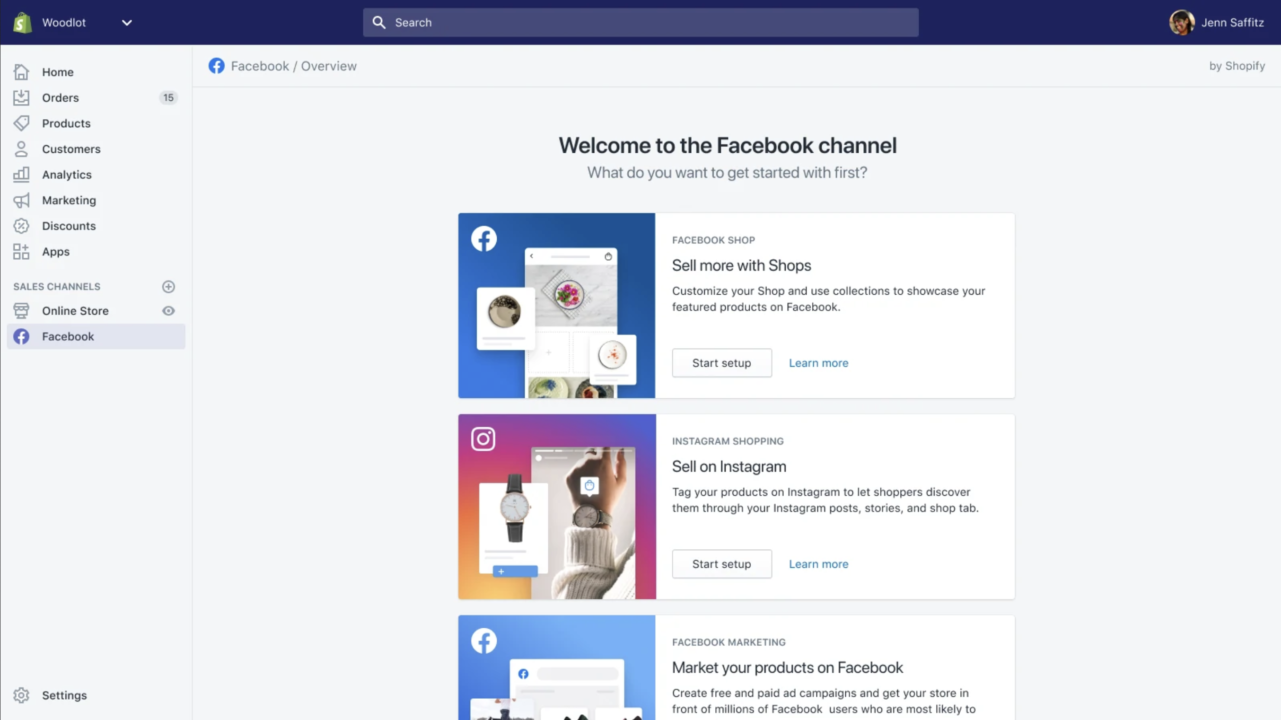
Both Shopify and BigCommerce have notable features that can help drive ecommerce sales. For example, Shopify features enable you to sell your products on various channels outside your website. So, you manage your products and process all your orders through a single storefront even when you sell on sites like Facebook and Instagram. Although you can do this on BigCommerce, you’ll need to rely on third-party services.
On the other hand, built-in BigCommerce features enable you to drive sales through more personalized shopping experiences. The platform offers a Customer Groups feature, which allows you to classify your customers into various segments. For example, you can create a high-loyalty group and offer them higher discounts as they shop. You can also create a wholesale group that can see product listings that aren’t visible to retail customers.
Out of the box, BigCommerce also offers better product filtering features. This makes it easier for shoppers to find what they need and makes them more likely to complete a purchase. Additionally, BigCommerce has a more streamlined checkout process, which lets shoppers complete their entire order all on one page.
Best for marketing features
In terms of marketing, BigCommerce vs Shopify can be a tricky subject since the typical tools you’ll need to drive demand for your business are available on both. For example, both Shopify and BigCommerce enable you to generate discount codes and gift cards to distribute to your shoppers.
Both BigCommerce and Shopify also offer a blogging engine. With proper content creation and blog management, this can be an extremely valuable asset for marketing and SEO. Additionally, all Shopify plans have abandoned cart recovery features while only the higher-tier BigCommerce plans offer this functionality.
Nevertheless, you’ll need to go beyond abandoned cart recovery if you want to maximize the value of your email campaigns. To do that, it’s better to disregard the built-in features and depend instead on external email marketing services. Thankfully, there are several high-performing email marketing tools for Shopify and the best ones are available on BigCommerce as well.
Apps, plugins and integrations
Apps, plugins, and third-party integrations make up for any features you might need but are not built into the platform you choose. So, app availability should be a critical consideration in the BigCommerce vs Shopify debate.
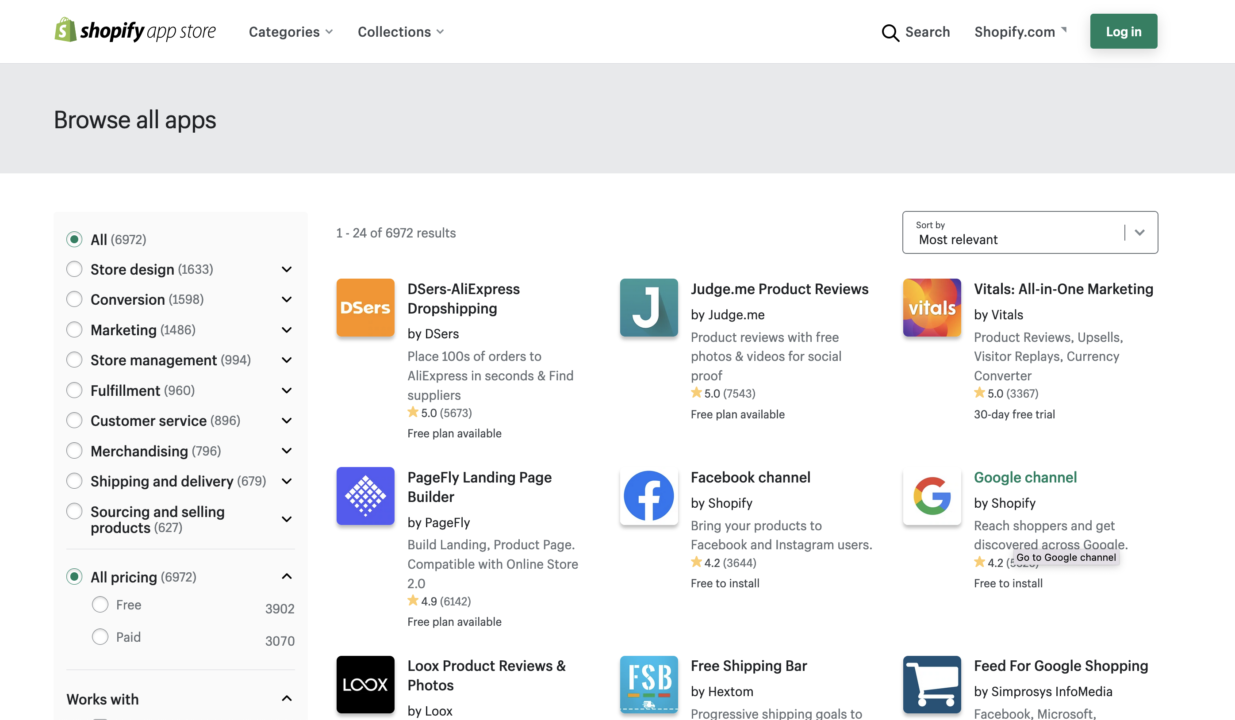
The Shopify app store contains over 7,000 apps across 9 categories. Over half of them are free to install. In contrast, the BigCommerce app store contains fewer than 1,100 apps with less than 400 free to install. However, BigCommerce categorizes its apps into 21 groups, which makes navigation and discovery so much easier if you don’t yet know what you’re looking for.
Even so, Shopify is the more advantageous platform merely because of the number of additional features you can integrate into your online store.
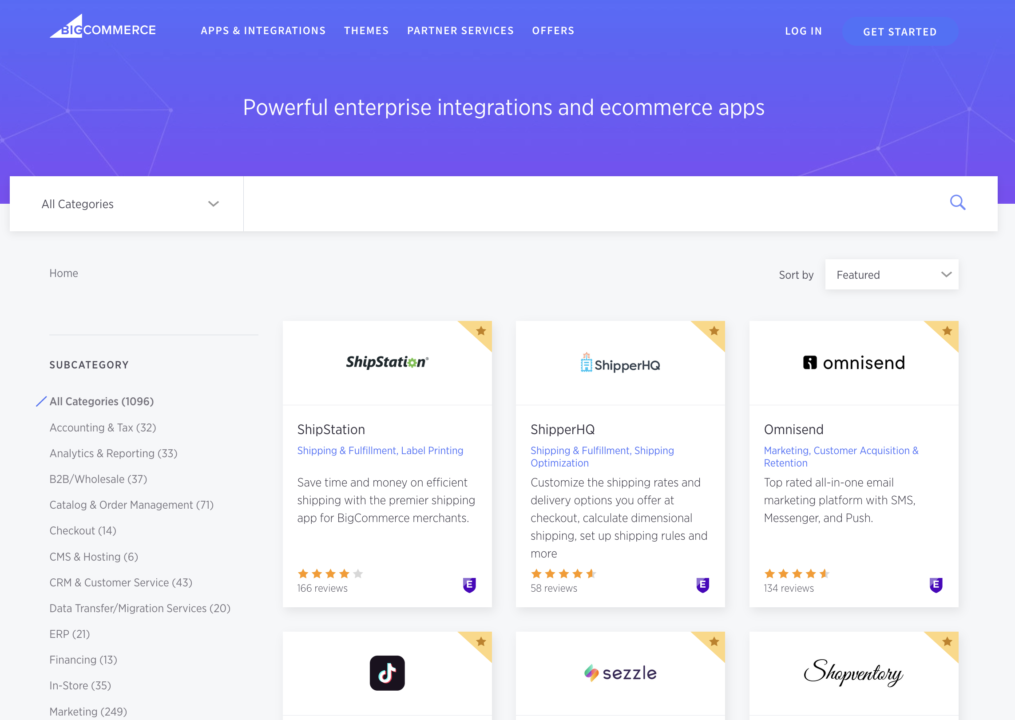
For some categories, the lack of app options makes sense. For example, BigCommerce’s Merchandising category has fewer than 100 apps compared to Shopify’s 800 apps in the same category. This is because BigCommerce already has many built-in tools to solve this, which is why fewer apps have been developed to expand the platform’s functionality. In contrast, Shopify relies heavily on additional services for extra merchandising features, which is why it has significantly more apps available in this category.
However, in other categories, the lack of app availability is simply a disadvantage. For example, built-in marketing features are comparable between the two platforms. However, marketing apps on BigCommerce totals less than 250 while Shopify has almost 1,500 in the same category.
Fortunately, the best Shopify apps are typically available on BigCommerce as well. For example, the Omnisend marketing automation app can be integrated into your ecommerce store as a Shopify app. In fact, Omnisend is a Shopify Plus certified app, which means it meets the highest quality standards of Shopify’s largest merchants.
Themes & templates
We’ve covered that Shopify wins in terms of ready-to-use designs while BigCommerce wins if you want a fully customized store. To put that in perspective, it helps to have a better appreciation of each platform’s theme store.
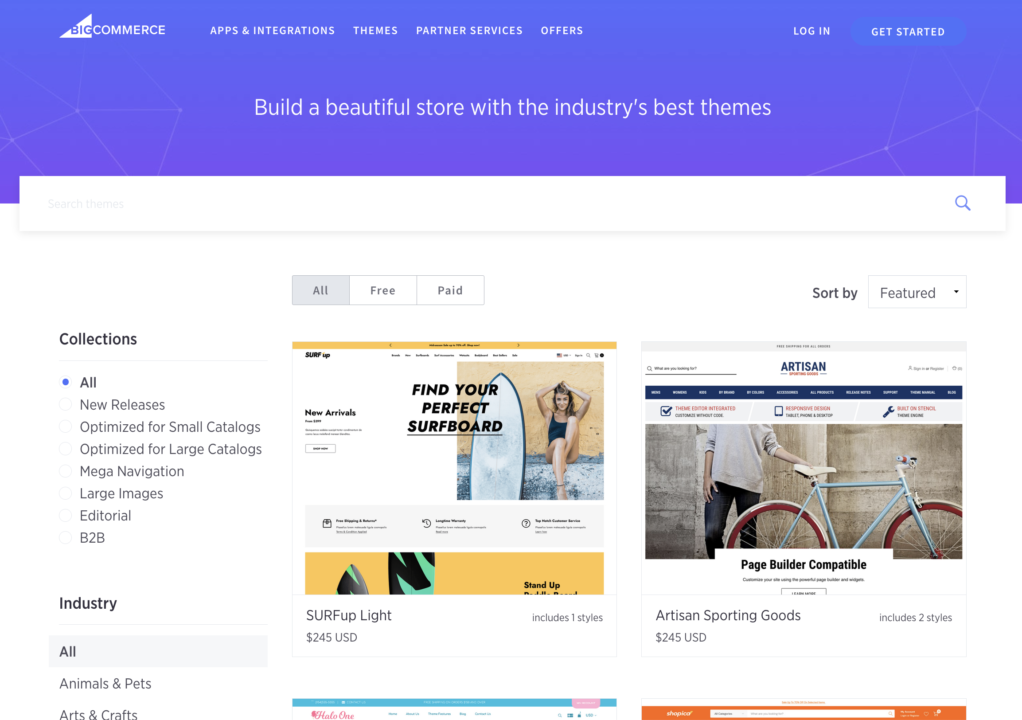
The BigCommerce theme store offers 12 free and over 175 paid themes. Prices for the premium options range from $150 to $300. Bigcommerce themes are grouped into 12 categories, which makes it easy to navigate through the store and find a suitable theme for your business.
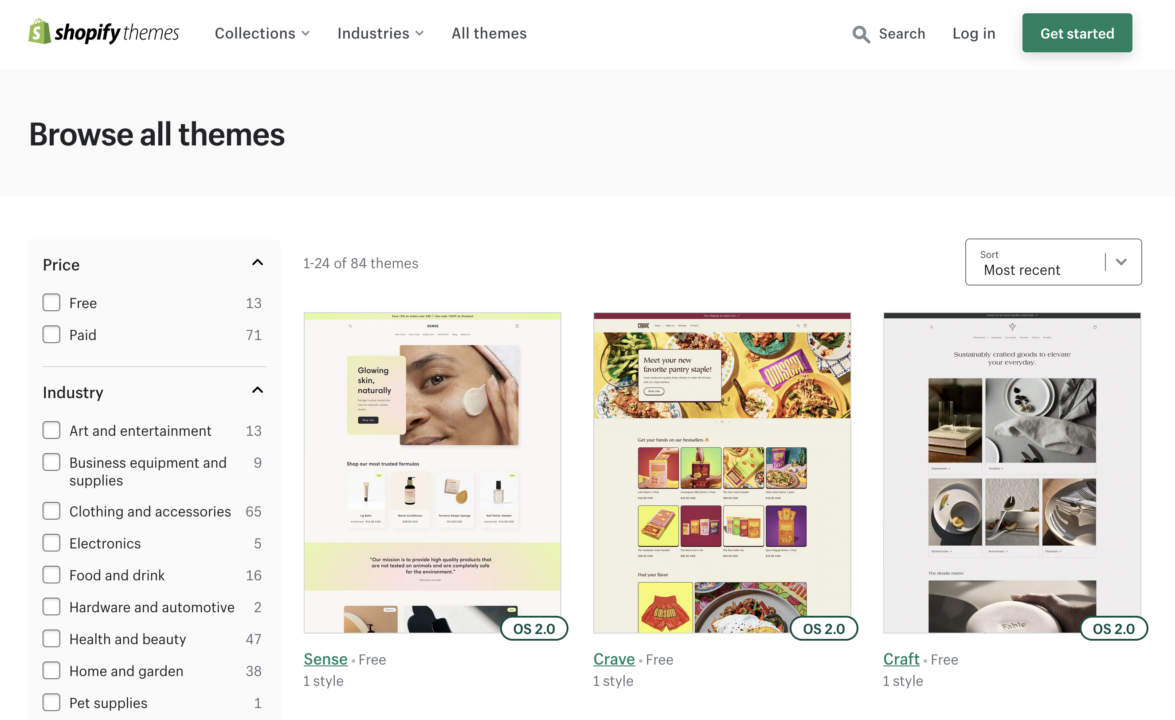
On the other hand, the Shopify theme store has 13 free options but only about 70 paid themes. These premium themes range in price from $150 to $350. But while Shopify’s store has fewer themes with slightly more expensive options, the designs tend to be more different from one another. That means you have more unique options to choose from.
Furthermore, you’ll find even more high-quality Shopify themes on template marketplaces. For example, Shopify themes on Envato’s Themeforest total over 1,300 while the same platform only offers about 85 BigCommerce themes. There are also cheaper Shopify themes on the site since these start at $19 while the cheapest BigCommerce theme is available for $39.
The same is true for the Template Monster theme marketplace where there are fewer than 20 BigCommerce themes available for $79 to $179 each. In contrast, the same store has over 1,400 Shopify themes, which sell for $39 to $179 each.
Nevertheless, choosing between Shopify or BigCommerce shouldn’t be just about the number of unique themes available. It will help to go through each of the marketplaces and determine which platform already has a theme that meets your requirements.
Security
Both BigCommerce and Shopify offer the level of security required to safely run an online store that handles payments and personal information. Both are compliant with PCI-DSS’ stringent standards, which protect you and your customers from cybercrimes like credit card fraud.
Additionally, all BigCommerce and Shopify plans include SSL certificates, which guarantee encrypted communication between your web server and your customers’ browsers. This prevents criminals from accessing and tampering with data, including sensitive personal information.
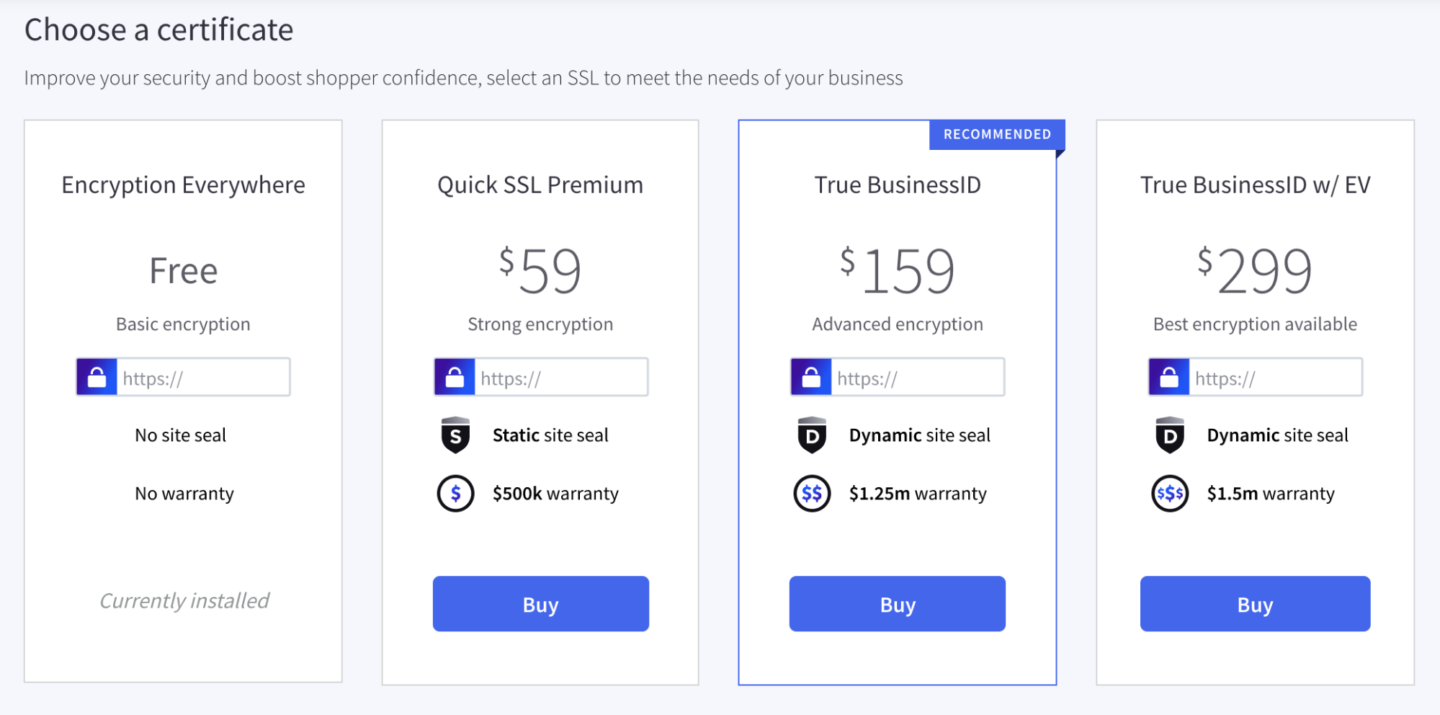
But while both platforms offer free basic encryption (which is usually enough for the typical SME), BigCommerce provides upgraded SSL certificates for merchants that handle more sensitive data and, therefore, require even better security. These plans include GeoTrust-verified certificates and range from $59 to $299 per year.
Each BigCommerce paid SSL plan enables you to display a padlock icon in the browser address bar and also lets you use a GeoTrust seal. These help boost the confidence of your shoppers, which ultimately leads to higher revenue. Additionally, these plans provide a warranty, which protects your customers’ purchases up to a certain dollar amount ranging from $500,000 to $1.5 million.
Support
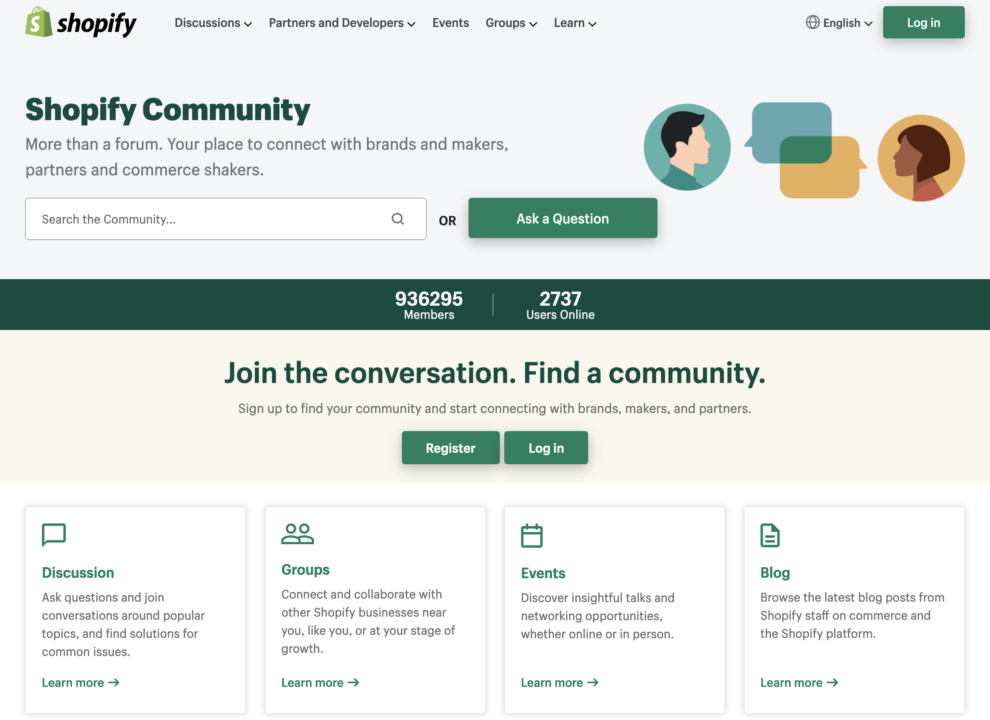
All Shopify and BigCommerce plans give you access to 24/7 tech support through email, phone, and chat. The wait time and the quality of support you get are comparable between the two service providers. However, the BigCommerce Help Center is much more helpful.
Shopify’s Help Center is more organized and easier to navigate. However, BigCommerce offers clearer and more detailed explanations to frequently asked questions. It also makes use of screenshots and images to make concepts easier to understand.
Where Shopify excels over BigCommerce is in the community discussion forums. BigCommerce’s Q&A community is small and lacks participation whereas Shopify’s community has almost a million members with thousands online at any given time, available to offer peer advice.
Wrap Up
BigCommerce vs Shopify is by no means an easy decision to make regardless of the scale and nature of your business. Undeniably, BigCommerce brings out the big guns by providing more features for product presentation, sales generation, and inventory management. For businesses that require more stringent security, it also allows for more advanced options.
But there’s a reason why Shopify is the more popular platform. Not only is it slightly less expensive (or significantly so if you’re willing to pay upfront) but it also allows for a quicker and simpler setup. The quality of designs and availability of themes and apps are also far superior on Shopify than BigCommerce.
Furthermore, you get the advantage of community support, which can sometimes be more helpful than accessing the 24/7 multichannel customer service that both platforms offer.
Regardless of the ecommerce platform you choose, Omnisend lets you automate the entire process of engaging your customers and driving sales. Start free.
quick links
related features
Take our short quiz to get a personalized recommendation on the best plan & features for your business.
Take the quizquick links
related features
No fluff, no spam, no corporate filler. Just a friendly letter, twice a month.
